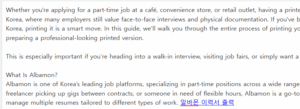Whether you’re applying for a part-time job at a café, convenience store, or retail outlet, having a printed copy of your resume can be extremely useful—especially in South Korea, where many employers still value face-to-face interviews and physical documentation. If you’ve built your resume on Albamon, one of the most popular job platforms in Korea, printing it is a smart move. In this guide, we’ll walk you through the entire process of printing your Albamon resume—from accessing it online to downloading it and preparing a professional-looking printed version.

This is especially important if you’re heading into a walk-in interview, visiting job fairs, or simply want a physical backup of your credentials. Let’s get started.
What Is Albamon?
Albamon is one of Korea’s leading job platforms, specializing in part-time positions across a wide range of industries. Whether you’re a student looking for weekend work, a freelancer picking up gigs between contracts, or someone in need of flexible hours, Albamon is a go-to resource. The platform allows users to search for jobs, apply directly, and manage multiple resumes tailored to different types of work. 알바몬 이력서 출력
What makes Albamon especially convenient is its digital resume system. You can build, store, and send resumes directly to employers without needing to print them—although printing can still be highly beneficial. 윤과장의 소소한 일상 이야기
Why Print Your Resume from Albamon?
There are several reasons why printing your Albamon resume could benefit your job search:
In-person applications: Many small businesses prefer applicants to visit directly.
Job fairs or hiring events: These often require physical copies of your resume.
Backups: A printed copy helps in case of website downtime or login issues.
Professional presentation: A neatly printed resume gives a better impression than scribbled personal info on a form.
Even if most of your job hunt is digital, keeping 3–5 printed copies in your bag is never a bad idea.
Step 1: Log Into Albamon
Go to www.albamon.com and log into your account using your registered email or phone number and password. If you’ve signed in with a social media account (e.g., KakaoTalk or Naver), use that login method.
Once you’re logged in, click on “MY Alba” or “MY PAGE” at the top right of the screen. This will bring you to your personalized dashboard.
Step 2: Access Your Resume(s)
On your dashboard, find the section labeled “Resume Management”. This is where all your saved resumes are stored. Albamon allows users to create multiple versions of resumes for different job types, such as cafés, office work, or delivery jobs.
Click the title of the resume you want to print. This will open a detailed view of the resume, including all your input information: personal details, work experience, education, certifications, and a self-introduction.
Step 3: Preview the Resume for Printing
Before printing, it’s best to preview how your resume will look. Most resumes on Albamon are formatted for both digital and print views.
Look for a button labeled “Preview” or “Print Resume”. Click it, and a formatted version of your resume will appear in a new window or tab.
This preview is how your resume will look once printed. Double-check for typos, spacing issues, or outdated information. If needed, close the preview and go back to make edits.
Step 4: Choose “Download” or “Print”
After confirming your resume is ready, you’ll have two main options:
Print directly: Click the “Print” button, usually represented by a printer icon. This will open your browser’s print dialog.
Download as PDF: In most browsers, you can choose “Save as PDF” instead of selecting a physical printer. This is great if you want to take your resume to a print shop or save it on a USB.
Pro tip: Saving your resume as a PDF ensures that no formatting is lost during printing. It also lets you attach the file to emails if needed.
Step 5: Adjust Print Settings
Whether you’re printing at home or at a copy center, use these tips for the best results:
Paper size: Set it to A4, which is standard in Korea.
Margins: Use “Normal” or “None” for clean edges.
Color settings: Choose grayscale or black-and-white if your resume doesn’t require color. This saves ink and looks more professional.
Double-sided printing: Only recommended if your resume is longer than one page.
After adjusting, click “Print” or “Save” depending on your method.
Step 6: Test Print
If this is your first time printing from Albamon, do a test print on scrap paper. Check alignment, font size, and spacing. If anything looks off, go back to the browser or resume editor and adjust.
Once satisfied, print your final copies on clean, high-quality paper. Avoid using colored or decorative paper—it might look unprofessional depending on the job.
Step 7: Organize and Prepare
Now that you’ve printed your resume, keep it in a folder or resume binder. Avoid folding or wrinkling the paper. You may also want to print multiple